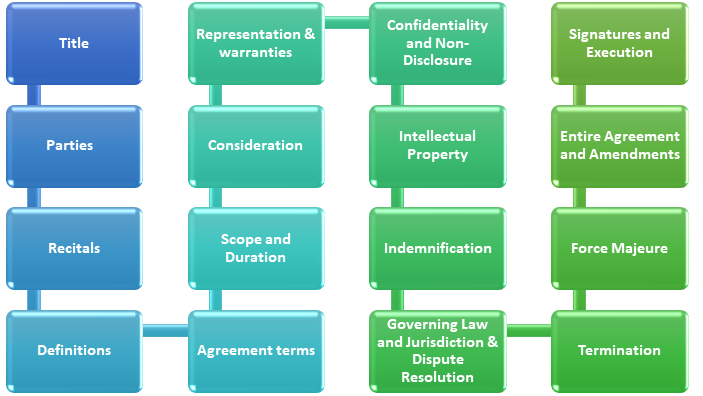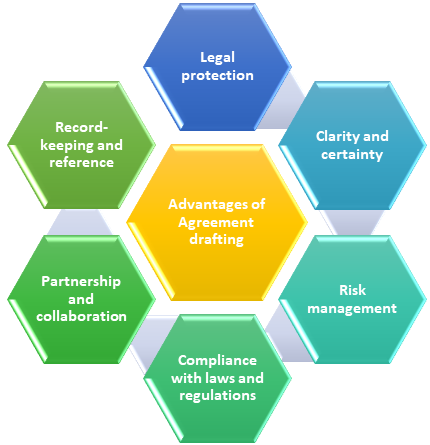Agreement Drafting
Agreement Drafting
RAAAS provides best Agreement Drafting services. We have chosen best talent from legal side and can help you get a concrete agreement drafted.
Agreement drafting refers to the process of creating a formal written document that outlines the terms and conditions agreed upon by two or more parties. It is a crucial step in the legal and business world when parties want to establish their rights, obligations, and expectations in a clear and enforceable manner.
What is to be included in Agreement drafting?
Drafting an agreement requires key elements for clarity, enforceability, and effectiveness. Here are some important components typically included in agreement drafting:
-
Title: A descriptive title that reflects the nature of the agreement.
-
Parties: Identify and provide the full names, legal entities, and addresses of all parties involved in the agreement.
-
Recitals: Include an introductory section that provides context, background, and the purpose of the agreement. This helps to establish the intentions and motivations of the parties.
-
Definitions: Define key terms used throughout the agreement to ensure a common understanding between the parties. This section clarifies any ambiguous or technical terms.
-
Agreement Terms: Clearly outline the specific terms and conditions of the agreement. This includes rights, obligations, responsibilities, and any limitations or restrictions.
-
Scope and Duration: Define the scope and boundaries of the agreement, specifying the activities, products, or services covered. Indicate the duration of the agreement, including any renewal or termination provisions.
-
Consideration: Describe the consideration exchanged between the parties, such as monetary payments, services, or other valuable items.
-
Representations and Warranties: Include statements of fact or assurances made by the parties regarding certain conditions, qualifications, or assertions.
-
Confidentiality and Non-Disclosur: If applicable, outline provisions for protecting confidential or proprietary information shared between the parties.
-
Intellectual Property: Address the ownership, use, and protection of intellectual property rights if relevant to the agreement.
-
Indemnification: Specify the obligations of the parties to indemnify and hold each other harmless from any losses, damages, or liabilities arising from the agreement.
-
Governing Law and Jurisdiction: Determine the laws governing the agreement and specify the jurisdiction in which any disputes will be resolved.
-
Dispute Resolution: Outline a mechanism for resolving disputes, such as mediation, arbitration, or litigation.
-
Termination: Define the circumstances and procedures for terminating the agreement, including any notice periods or termination rights.
-
Force Majeure: Include provisions to address unforeseen events or circumstances beyond the control of the parties that may impact the performance of the agreement.
-
Entire Agreement and Amendments: Clarify that the agreement represents the entire understanding between the parties and that any amendments must be made in writing and agreed upon by all parties.
-
Signatures and Execution: Provide space for the parties to sign and date the agreement, indicating their acceptance and intention to be bound by its terms.

Need of Agreement drafting
Agreement drafting is essentials for several reasons:
-
Clarity and understanding: A well-drafted agreement ensures clarity, minimizes ambiguity, and reduces future disputes by addressing all parties' rights and expectations.
-
Legal enforceability: Properly drafted and executed agreements are more legally enforceable, providing a framework for dispute resolution and demonstrating commitments.
-
Protecting interests: Agreement drafting safeguards interests by addressing concerns and risks, enabling favorable negotiation and terms.
-
Minimizing risk: An agreement minimizes risks by defining rights, responsibilities, and remedies for parties, addressing issues like liability.
-
Establishing a foundation for relationships: Agreements formalize relationships, promoting transparency, trust, and collaboration in business partnerships, employment, and vendor contracts.
-
Compliance and regulation: Agreements must address legal and regulatory requirements in specific industries to ensure compliance with industry standards.
-
Record-keeping and reference: Written agreement is a valuable record for parties to review obligations and rights, preventing misunderstandings.
Advantages of Agreement Drafting
-
Legal protection: Well-drafted agreements offer legal protection for organizations by clearly outlining rights, obligations, and responsibilities.
-
Clarity and certainty: Agreements provide clarity, preventing misunderstandings and promoting efficient decision-making in business relationships.
-
Risk management: Agreement drafting helps organizations identify and address risks and liabilities, including indemnification and limitation of liability.
-
Compliance with laws and regulations: Agreements ensure organization complies with laws, regulations, and industry standards, demonstrating commitment to legal framework.
-
Partnership and collaboration: Agreements crucial for establishing partnerships and collaborations, defining rights, responsibilities, and expectations for mutual success.
-
Record-keeping and reference: Agreements serve as record-keeping for terms and conditions, ensuring consistent understanding and alignment for internal and external stakeholders.

